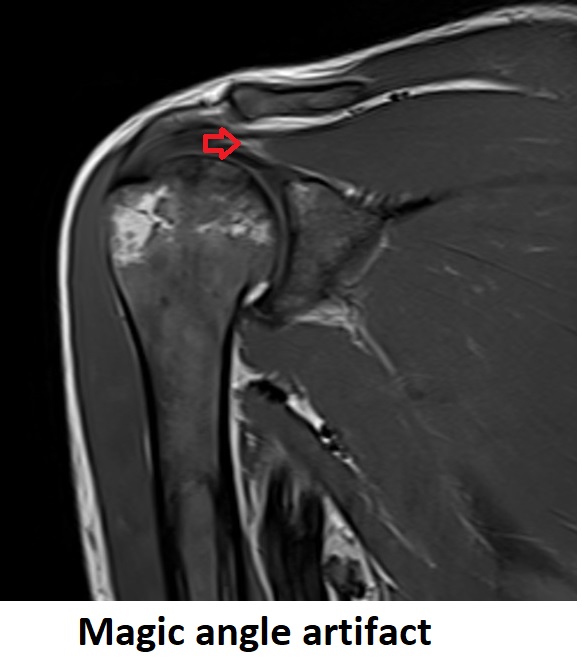MRI Magic Angle Artifact
The magic angle artifact is an MRI artifact that occurs due to the phenomenon of nuclear dipole-dipole interactions. It appears as a bright signal on T1-weighted images and can occur in tissues with highly organized collagen fibers, such as tendons, ligaments, and cartilage.
When the tissues are aligned at approximately 55 degrees to the main magnetic field (known as the magic angle), there is an increase in the signal intensity on T1-weighted images, leading to a bright or hyperintense appearance. This effect is caused by the interaction between the collagen fibers and the magnetic field, resulting in shortening of the T2 relaxation time. The resulting image can have a characteristic appearance, which includes:
Bright and sharp signal intensity: The affected tissue may appear bright and sharply defined on the MRI scan, which can mimic the appearance of a true abnormality.
Linear or curvilinear patterns: The artifact may produce linear or curvilinear patterns that appear superimposed over the underlying tissue, which can be mistaken for a real structure or lesion.
Signal voids: In some cases, the artifact can cause signal voids or areas of low signal intensity that may be mistaken for true pathology.

Here are some strategies to minimize or avoid Magic Angle Artifact
Changing the imaging sequence: Using sequences such as STIR (Short T1 Inversion Recovery) or FSE (Fast Spin Echo) can reduce the artifact.
Using a lower field strength: The artifact can be reduced by using lower field strengths, such as 1.5T instead of 3T.
Adjusting imaging parameters: Changing the angle of the imaging plane or increasing the repetition time (TR) and echo time (TE) can help avoid this artifact.
Using a higher b-value: In diffusion-weighted imaging, increasing the b-value can reduce the Magic Angle Artifact.
Patient repositioning: Repositioning the patient can help reduce the effect of the Magic Angle Artifact by changing the angle between the collagen fibers and the imaging plane.
References:
- Thawait GK, Subhawong TK, Thawait SK, et al. Magic angle effect: a cause of increased signal intensity in the normal lateral patellar tendon on short-tau inversion recovery (STIR) images. Skeletal Radiol. 2012;41(5):545-551. doi:10.1007/s00256-011-1274-


